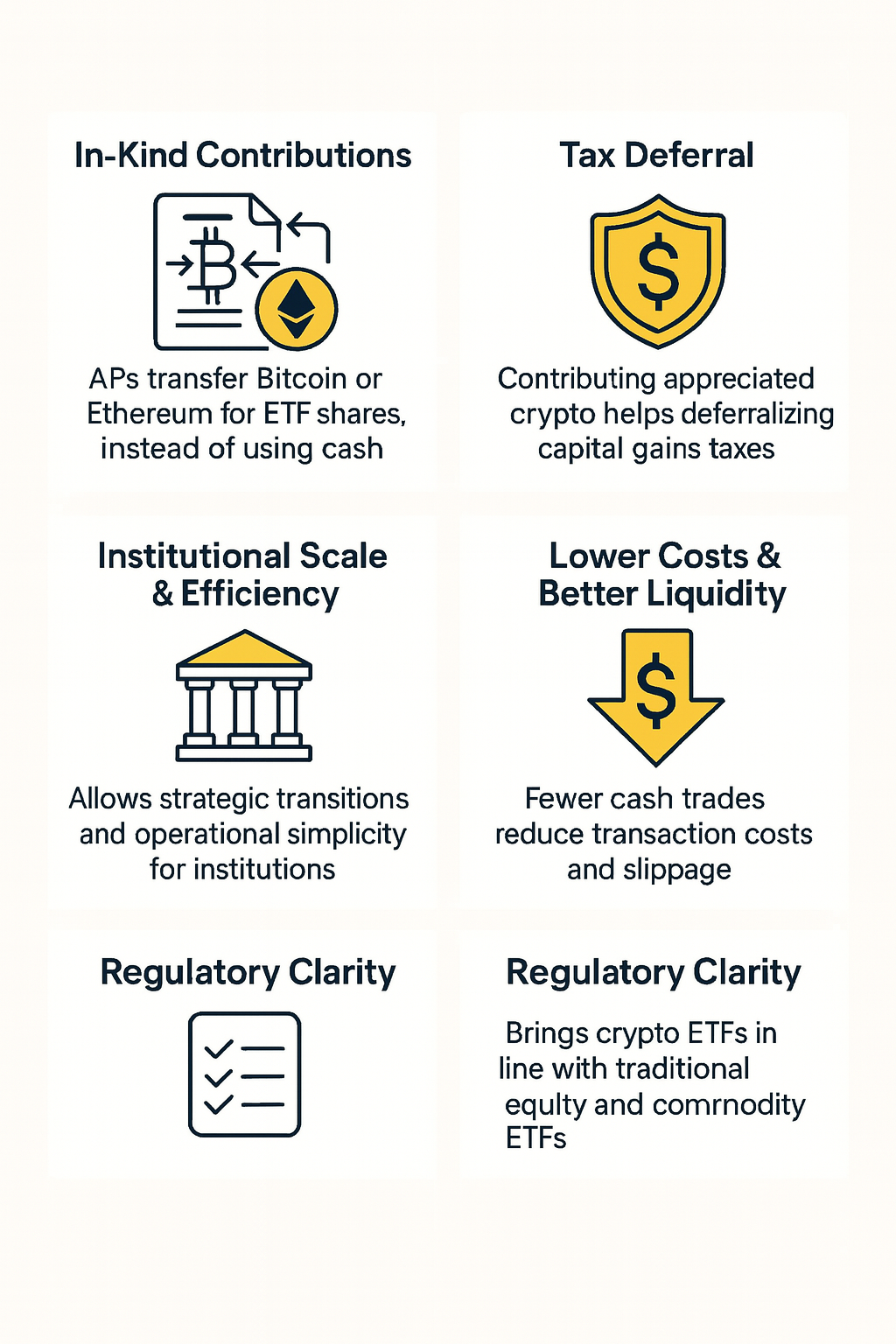How In-Kind Contributions Are Revolutionizing Bitcoin & Ethereum ETFs: A Game-Changer for Investors
On July 29, 2025, the U.S. Securities and Exchange Commission (SEC) announced a landmark decision that is set to redefine the crypto investment landscape: the greenlight for in-kind creations and redemptions for Bitcoin and Ethereum ETFs. This pivotal policy shift unlocks a wealth of tax-efficient, cost-effective, and scalable opportunities for investors, from large institutions to individual enthusiasts, allowing them to engage with dynamic crypto markets through regulated exchange-traded products. Let's delve into why in-kind contributions are a true game-changer and the tangible benefits they offer you.
What Exactly Are In-Kind Contributions?
At its core, an in-kind contribution allows authorized participants (APs) or investors to transfer Bitcoin or Ethereum directly into an ETF in exchange for shares. This innovative approach entirely bypasses the traditional requirement to sell assets for cash, a process that can be both cumbersome and costly. Unlike the previous cash-only model, in-kind transfers provide significant advantages:
- Tax Efficiency: Critically, there's no taxable event triggered upon contribution, allowing investors to preserve valuable capital gains.
- Lower Costs: Reduced transaction fees and minimized market slippage mean more of your investment goes further.
- Seamless Transactions: For large holders, this translates to easier entry and exit, streamlining the investment process.
This mechanism effectively eliminates the friction associated with cash-based flows, making ETFs an even more efficient and attractive wrapper for crypto investments.
The Strategic Power of Tax Deferral
As highlighted in Bloomberg's insightful July 22, 2025, article, "Capital Gains Vanish Into ‘Black Holes’ in Latest ETF Tax Trick," in-kind contributions empower investors to defer capital gains taxes under IRS Section 351. For Bitcoin or Ethereum holders who have accumulated significant unrealized gains, this offers a powerful pathway:
- Tax-Free Transfers: Move your crypto directly into an ETF without triggering immediate tax liabilities.
- Diversified Exposure: Gain exposure to diversified, professionally managed, and regulated products.
- Flexibility on Your Terms: Rebalance or liquidate your holdings later, aligning with your personal financial strategy.
As the legendary Vanguard founder Jack Bogle famously quipped, tax deferral is akin to an “interest-free loan from the government,” providing a crucial advantage by allowing your capital to compound and grow for a longer period.
Case Study: In-Kind in Action
Bloomberg previously showcased how traditional ETFs, such as the Twin Oak Active Opportunities ETF (TSPX), successfully leveraged in-kind transfers to defer taxes. TSPX, for instance, launched with $450 million, a substantial portion of which included a $99 million in-kind transfer of Snowflake stock. This stock was then swapped for S&P 500 exposure within the fund, all without triggering capital gains for the initial contributors.
Now, crypto ETF investors can replicate this highly effective strategy. By transferring Bitcoin or Ethereum into these ETFs tax-free, they can then rebalance their portfolios within the fund, utilizing sophisticated "heartbeat trades" to optimize allocations without incurring immediate tax consequences.
Beyond Taxes: Unlocking Cost Savings and Enhanced Liquidity
The benefits of in-kind contributions extend far beyond tax advantages, delivering significant operational efficiencies:
- Reduced Transaction Costs: Authorized participants avoid the need to buy and sell crypto on various exchanges, reducing overhead.
- Minimized Slippage: This is particularly critical for volatile assets like Bitcoin, where small price movements can impact large trades.
- Tighter Tracking: A closer alignment between the ETF's Net Asset Value (NAV) and its market price ensures greater precision for investors.
- Enhanced Liquidity: Market makers can arbitrage more efficiently, leading to narrower bid-ask spreads and better execution for all.
These combined advantages directly translate to improved performance for retail investors and highly scalable exposure solutions for institutions.
Regulatory Clarity Fuels Innovation
The SEC’s decisive July 29 approval brings U.S. crypto ETFs in line with global standards, mirroring practices already common in markets like Canada and Europe where in-kind flows are standard. As stated in the SEC's press release 2025-101, SEC Chairman Paul S. Atkins noted, “It’s a new day at the SEC, and a key priority of my chairmanship is developing a fit-for-purpose regulatory framework for crypto asset markets. I am pleased the Commission approved these orders permitting in-kind creations and redemptions for a host of crypto asset ETPs. Investors will benefit from these approvals, as they will make these products less costly and more efficient." Jamie Selway, Director of the Division of Trading and Markets, added, "The Commission’s decision today is an important development for the growing marketplace for crypto-based ETPs. In-kind creation and redemption provide flexibility and cost savings to ETP issuers, authorized participants, and investors, resulting in a more efficient market.”
This newfound regulatory clarity empowers ETF issuers to:
- Seamlessly rebalance separately managed accounts (SMAs) into ETFs.
- Consolidate low-basis crypto positions in a tax-efficient manner.
- Strategically manage legacy portfolios with tax-deferred exit strategies.
This pivotal development positions crypto ETFs to directly compete with traditional equity and commodity ETFs, promising to accelerate adoption and foster significant innovation within the digital asset space.
Why This Matters for Every Investor

The approval of in-kind contributions unequivocally transforms crypto ETFs into a gold standard for investors seeking regulated, efficient, and sophisticated exposure to digital assets. The key benefits are clear:
- Unrivaled Tax Deferral: Keep more of your capital working for you, free from immediate tax hits.
- Superior Cost Efficiency: Enjoy lower fees and tighter spreads, directly boosting your overall returns.
- Effortless Accessibility: Transition smoothly from direct crypto holdings to robust, regulated products.
- Broad Institutional Appeal: Gain scalable, capital-efficient exposure perfectly suited for large-scale investors.
As the global ETF market continues its rapid ascent, projected to reach $15 trillion by 2025, the integration of in-kind functionality firmly establishes crypto ETFs as a must-have component for serious investors.
- ✅ Defer capital gains tax when entering an ETF
- ✅ Keep more capital compounding, longer
- ✅ Benefit from lower costs and tighter liquidity
- ✅ Transition from direct crypto exposure into regulated wrappers
- ✅ Align with institutional standards and operational best practices
About the Author
Rali Perduhova is the Co-Founder & CEO of 7RCC Global Inc - a next-generation ETF issuer bridging sustainability, regulation, and digital asset innovation.





